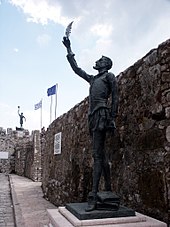Nafpaktos
|
Municipality of Nafpaktos Δημοτική Κοινότητα Ναυπάκτου (Ναύπακτος) |
||
|---|---|---|
|
|
||
| Basic data | ||
| Country |
|
|
| region | West Greece | |
| Regional district | Aetolia-Acarnania | |
| local community | Nafpaktia | |
| Parish | Nafpaktos | |
| Geographic coordinates | 38 ° 24 ' N , 21 ° 50' E | |
| Height above d. M. |
15 m (average) |
|
| surface | 16.725 km² | |
| Residents | 13415 (2011) | |
| Local division | 1 | |
Nafpaktos ( Greek Ναύπακτος ( f. Sg. ), German often also Naupaktos , Italian Lepanto , Turkish İnebahtı ) is a western Greek port city at the entrance to the Gulf of Corinth . It is the administrative seat of the municipality of Nafpaktia, which was created in 2010 from six municipalities .
Nafpaktos is the seat of a metropolitan diocese of the Greek Orthodox Church . Metropolitan is currently the important theologian Bishop Hierotheos Vlachos .
location
The urban area of Nafpaktos extends over 16.725 km² from the mouth of the Mornos into the Gulf of Corinth over the Bay of Nafpaktos (Όρμος Ναυπάκτου Ormos Nafpaktou ) about 3 km west. It is only enough a maximum of 2 km into the hinterland.
history
Naupaktos was one of the most important ports of the western Lokris . 455 BC It was snatched from the Locrians by the Athenians and occupied by fleeing Messenians . In the Peloponnesian War it was a naval station of the Athenians , but it was given to them in 405 BC. And the Messenians were driven out. 338 BC The Aetolians seized the city, which they owned in 191 BC. Defended against the Romans for a long time, but in vain . In 217 BC Chr. Was closed here Peace of Naupactus of the Social War ended (220-217) between Philip V of Macedon and his allies against the Aetolians and their allies.
In the Middle Ages, the city was left to the Venetians by the Byzantine Emperor Emanuel , who fortified it so strongly that in 1477 a 30,000-strong Ottoman army had to withdraw after four months of siege. It was not until 1499 that Bayezid II was able to force the city to surrender with an army of 150,000 men.
At the naval battle of Lepanto on October 7th, 1571, the Venetian-Spanish fleet under Don Juan de Austria defeated the Ottoman fleet stationed there. It was the last great and extremely bloody galley battle in the Mediterranean that ushered in the end of Turkish domination. A monument at the Venetian port commemorates Miguel de Cervantes , who lost his left hand in this battle.
Since 1678 Nafpaktos was again Venetian property as Lepanto, but was again assigned to the Ottoman Empire in the Peace of Karlowitz in 1699. As a result of the Greek struggle for freedom , Nafpaktos was handed over to the Greeks on March 27, 1829.
Since it was founded as a rural community in 1912, the area of the community has changed several times through area corrections, even after it was elevated to a community in 1946. Even after the 1997 regional reform, the city of Nafpaktos remained the seat of the municipality of Nafpaktos, which was expanded by 13 rural parishes. As part of the 2010 administrative reform , the municipality of Nafpaktos was merged with five other municipalities to form the municipality of Nafpaktia . Since then, the city of Nafpaktos has had the status of a city district in the municipality of the same name and is the administrative seat of the municipality.
Attractions
Besides the harbor, there are many traditional houses (including the house of the Botsaris family with a small museum) and the castle above the town.
Individual evidence
- ↑ Results of the 2011 census at the National Statistical Service of Greece (ΕΛ.ΣΤΑΤ) ( Memento from June 27, 2015 in the Internet Archive ) (Excel document, 2.6 MB)
- ^ Frank W. Walbank : Philip V of Macedon . Cambridge 1940, pp. ???.
- ↑ Κεντρική Ένωση Δήμων και Κοινοτήτων Ελλάδας (ΚΕΔΚΕ) Ελληνική Εταιρία Τοπικής Ανάπτυξης και Αυτοδιοίκησης (ΕΕΤΑΑ) (ed.): Λεξικό Διοικητικών Μεταβολών των Δήμων και Κοινοτήτων (1912-2001). 2 (Τόμος Β, λ – ω), Athens 2002, ISBN 960-7509-47-1 , p. 185 f.



